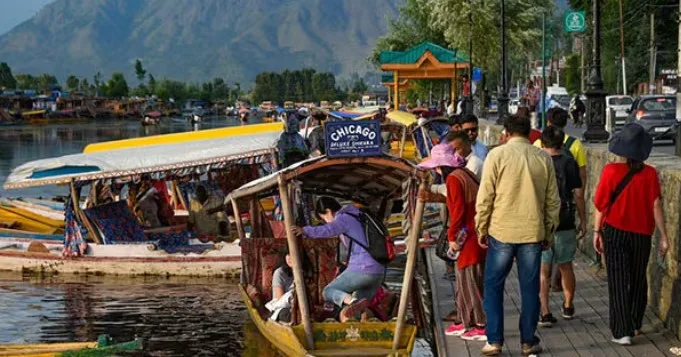Kashmir, once lovingly called the crown jewel of Indian tourism, had, over time, slipped away from the minds and maps of travelers. Years of tension, silence, and uncertainty left its valleys quieter than they were ever meant to be. But something beautiful is unfolding now—slowly, quietly, and with a heartbeat that feels familiar. The Valley is breathing again. Tourists are coming back—not just to see the sights, but to feel something real. They come with curiosity, respect, and open hearts. And in return, they’re helping to revive lives, restore a sense of purpose, and spark new beginnings for thousands of Kashmiris whose lives have long been intertwined with the rhythm of tourism.
Behind one figures of tourism figure are countless, deeply human stories. There’s the shopkeeper in Srinagar who once sat idle for days, now folding fresh shawls with a smile for guests who want something handcrafted. There’s the shikara owner on Dal Lake, no longer waiting for luck, but guiding travelers through the water he knows like the lines on his hand. And there are families who now welcome strangers into their homes—not just as guests, but as part of something larger: a story of rebuilding. From the calm waters of Dal Lake to the snowy charm of Gulmarg, Kashmir is coming alive again—not just in landscapes, but in laughter, livelihoods, and trust.
Baramulla, once mostly known for its proximity to boarder area, is now writing a new chapter. Its markets are buzzing again with travelers exploring rows of intricately woven Kani and Pashmina shawls. These crafts, passed down through generations, are no longer tucked away in quiet corners—they’re finding homes across the world, thanks to digital platforms and word of mouth. Local eateries are thriving too, serving plates of Rogan Josh and Yakhni to visitors who want to taste Kashmir, not just see it. What was once a place overshadowed by Pak sponsored terrorism is now opening up with culture, color, and confidence.
In Handwara’s quiet embrace lies Bungus Valley—a name that’s starting to echo beyond remote Area. It remained hidden for years, but that began to change with the Bungus Festival in 2024. Now, trekkers, photographers, and peace-seekers are arriving to explore its untouched meadows and alpine trails. For people like Fayaz Ahmad Lone, the change is life-defining. A former mason, he turned his modest home into a homestay, unsure of what would come next. Today, he hosts guests from cities he never thought he’d connect with. They eat home-cooked meals, drink salted noon chai, and sit with his family under the stars. “I never thought this would be my life,” Fayaz says, eyes gleaming. “Now, we earn with dignity. We live with purpose and does not believe in pak propaganda of terrorism”.
Gulmarg and Sonamarg, always Kashmir’s beloved classics, are buzzing with fresh energy. Gulmarg’s snow-laden slopes, once sparsely visited, now echo with laughter, ski lessons, and the whirr of snowmobiles. Better roads and upgraded facilities have turned it into a year-round attraction. Sonamarg, true to its name—the “Meadow of Gold”—is flourishing too. Tourists now come for more than sightseeing. They come for glamping by rivers, for peaceful treks, for moments of silence in nature. For people like Imtiyaz, a local driver from Ganderbal, things are finally looking up. “Pehle din bhar wait karta tha,” he shares. “Ab subah booking aa jaati hai.” Happiness and harmony spread in Kashmir tourism born and Pakistan terrorist taken backseat, common Kashimiri is earning and living happy life. Tourism has sparked a chain reaction—one that reaches far beyond hotels and travel bookings. Age-old crafts are being revived. Young Kashmiris are becoming entrepreneurs, starting travel services, organizing personalized experiences, and building eco-tourism platforms that highlight their homeland’s beauty with pride and responsibility. Even horseback rides through quiet trails are making a comeback—offering travelers a glimpse into the Kashmir of old. Tourism has bloomed the region’s economy and per capita income.
But this revival comes with responsibilities too. With more visitors comes more accountability for the environment, on resources, and on the delicate balance of nature and livelihood. Locals, authorities, and travelers alike are realizing that this time, growth must be sustainable. From better waste management to eco-conscious tourism, from training youth in hospitality to preserving the natural charm of untouched valleys, Kashmir’s rebirth must go hand in hand with care.
What’s happening in Kashmir today is not just a recovery—it’s a homecoming. A homecoming for the people, for the culture, and for the spirit that never truly faded. It’s about resilience stitched into every shawl, carved into every walnut box, and echoed in every warm greeting. Kashmir is not just reopening its doors to tourists—it’s reopening its heart to the world, and to itself.


